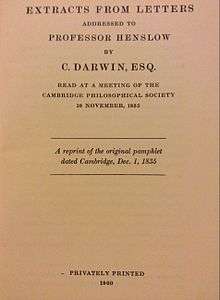Extracts from Letters to Henslow
Extracts from Letters to Henslow is an 1835 pamphlet published by John Stevens Henslow at his own expense of extracts from ten letters Charles Darwin sent him while on HMS Beagle. This pamphlet helped to establish Darwin's reputation amongst renowned scientific publications. However, upon learning of this pamphlet's publication Darwin was "a good deal horrified" at Henslow making public "what had been written without care or accuracy".[1]
Background
Darwin came to know Henslow through his attendance at his scientific talks at Cambridge University. He had heard of Henslow through his brother Erasmus who greatly revered him as a man of scientific brilliance and integrity. Although he was actually studying theology, inspired by Henslow he soon became a visitor to Henslow's house and subsequently met the scientific fraternity.
Henslow obviously rated Darwin highly although at the time Darwin had few formal credentials. This is evident by Henslow's consideration that Darwin should accompany Robert FitzRoy as a companion on the voyage of the Beagle. Henslow had initially been asked himself. He turned this down, dissuaded by his wife. His brother-in-law (Leonard Jenyns) then accepted the post but changed his mind at the last moment.
It was at this point that Henslow sent FitzRoy a letter indicating that he knew someone who would perfectly fit the bill and then wrote Darwin a letter who was on a field trip in Wales with Sedgewick (Professor of Geology) at the time. On his return to Shrewsbury he found a letter from Henslow telling him of his recommendation that Darwin be companion/naturalist to Captain FitzRoy.
The Extracts
Whilst on the Beagle Darwin corresponded continuously with Henslow, not only writing but sending him a huge collection of samples. Henslow sent fragments of Darwins letters to renowned scientific publications which assured Darwin of a more than respectable reputation. He also compiled quotes from ten letters and published them privately at his own expense for the Cambridge Philosophical Society and associates.
The original pamphlet is now rare. According to American Book Prices Current only four copies have appeared at auction since 1975. Freeman 1; Norman 583. On 19 June 2014 Christies auctioned an original copy in New York (Sale 2861) and realised $221,000.
In 1960 it was reprinted privately for the same circulation.

The preface by Dr. Sydney Smith in the 1960 reprint contends that the value of reprinting was partially because this was 'the first writing of Charles Darwin ever to be published.' This is not quite true, as Darwin had already been published in Records of captured insects, Stephens, J. F., Illustrations of British entomology 1829-1832
Notes
- Barlow, ed., Charles Darwin and the Voyage of the Beagle, pp. 140–42.
References
- Barlow, ed., Charles Darwin and the Voyage of the Beagle, pp. 140–42).
- [Records of captured insects], Stephens, J. F., Illustrations of British entomology, 1829-1832
- Extracts from Letters to Henslow (1960) Private Printing